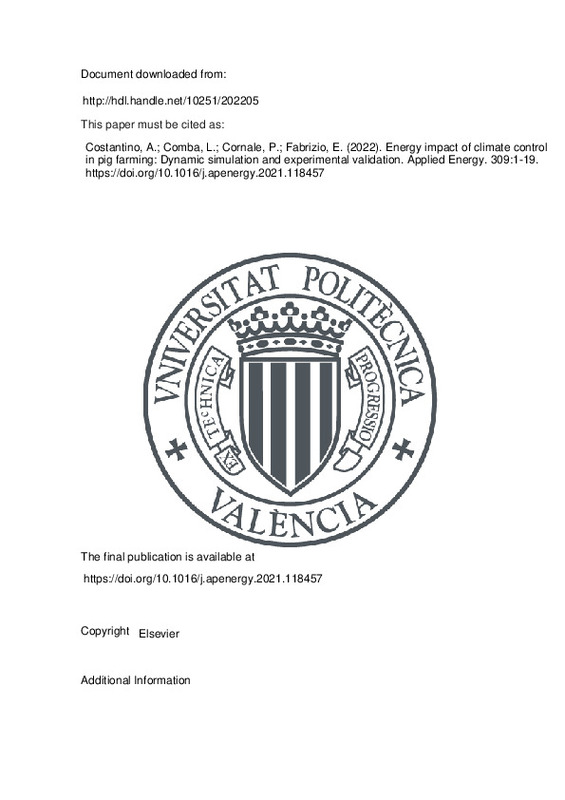|
Resumen:
|
[EN] Pig farming is one of the most energy consuming activities of the livestock sector. A considerable amount of energy, in fact, is needed to maintain the adequate indoor climate conditions in mechanically ventilated pig ...[+]
[EN] Pig farming is one of the most energy consuming activities of the livestock sector. A considerable amount of energy, in fact, is needed to maintain the adequate indoor climate conditions in mechanically ventilated pig houses. This energy consumption is remarkably increasing due to the boost of pork demand -+45% between 2010 and 2050- enhanced by socio-demographical changes. Consequently, the improvement of the energy performance of this building type is becoming more and more a primary target in the path toward an energy-smart food production. Energy simulation models are essential to achieve such ambitious target by enhancing the analysis of energy consumption patterns and the evaluation of potential energy-efficient measures. A well-established and shared energy framework for this specific aim is not present in literature as well as simulation models for the efficient-energy design of pig houses, outlining an important gap that hinders the transition toward an energy-smart agriculture. In this work, a new dynamic energy simulation model is developed for the estimation of the energy consumption for climate control of mechanically ventilated growing-finishing pig houses. This model contributes to the current body of knowledge by providing stakeholders with an innovative and effective simulation model for energy analyses, especially at the design stage. In addition, this work faces an innovative and challenging energy modelling activity that can contribute to the development of an energy-smart food production by proposing a structured energy simulation framework for livestock houses. Furthermore, this model contributes to bridge the gap between energy and agricultural engineering simulation models by modelling in detail the pig-environment interactions and their effects on the energy consumption of the livestock house. The reliability of the model was performed through an experimental validation against real monitored data in compliance with international protocols. The developed model could represent an effective decision support tool for stakeholders, especially in the design stages of pig houses by favouring the adoption of new technologies in this sector. Through this model, in fact, the impact of new energy-efficient solutions on the energy performance of pig houses can be evaluated in standardized conditions, considering the specific features, such as building layout, geographical location, and farming features.
[-]
|
|
Agradecimientos:
|
This work has been supported by financial funding of SIR (Scientific Independence of young Researchers) 2014 "EPAnHaus -Energy Performance of livestock houses" project, grant number RBSI141A3A, funded by MIUR (Italian ...[+]
This work has been supported by financial funding of SIR (Scientific Independence of young Researchers) 2014 "EPAnHaus -Energy Performance of livestock houses" project, grant number RBSI141A3A, funded by MIUR (Italian Ministry of Education, Universities and Research). The Authors thank the Regional Agency for the Protection of the Environment of Piemonte (ARPA Piemonte) for the outdoor weather data needed for this work and Dr. Ugo Benedetto and his staff for their willingness to take part in the project.
The Authors thank also prof. Luca Battaglini from University of Torino -DiSAFA, for the support and advice during this research.
[-]
|







![[Cerrado]](/themes/UPV/images/candado.png)




